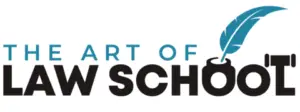Ever feel like you’re standing at the foot of a financial mountain, peering up at the towering peak known as law school? You’re not alone.
The price tag attached to this prestigious journey can be daunting – almost like an Everest waiting to be climbed. But what if we told you that it’s possible to map out your path, understanding each twist and turn before taking those steps?
In this article, we will dissect every layer of cost associated with law school – from tuition fees and living expenses to unexpected costs hidden around the corner.
But wait! We won’t leave you stranded in snowstorms without hope. We’ll also navigate through scholarships, grants and loans.
Buckle up for a comprehensive guide on minimizing costs while maximizing opportunities in your legal education journey!
Jump Ahead To:
Understanding the Cost of Law School

Grasping the price of legal education is an essential initial step on your way to becoming a lawyer. But remember, tuition isn’t the only factor to consider.
The cost of law school varies greatly depending on several factors. U.S News and World Report reported the yearly tuition for private law schools as $49,312 in 2023-2023 while public ones averaged $28,186 annually.
Tuition Costs Are Just The Beginning
In addition to tuition, students should plan for expenses such as housing, utilities and food costs, as well as books which can range from $1,500 – $3,000 annually. Additionally, one-time expenses like moving costs or setting up your new apartment can also increase initial outlays.
A Peek at Other Expenses
Other possible expenditures include health insurance premiums (if not covered by your school), bar exam preparation courses which may run into thousands of dollars, and potential travel expenses if you’re considering studying away from home.
The Reality Of Student Loans
If those numbers are making you sweat already don’t panic yet. There’s help available through scholarships and student loans that might make things more manageable. The reality though is that many law students graduate with substantial debt. NALP’s 2018 research revealed the average law school student graduates with over $145,000 in educational debt.
The decision to attend law school is a significant one both personally and financially. Knowing all of these costs upfront will let you plan better for this big step towards your legal career.
Curious about what law school you can get admitted to? Check out our admissions predictor!
Factors Influencing Law School Costs
The price tag of a law school education can differ significantly, with several contributing elements. Location is one key aspect that affects the overall cost. For example, schools in major cities like Columbia University in New York City, tend to be more expensive due to higher living costs.
Prestige also comes with a price tag. Highly ranked law schools often have steeper tuition fees but offer more opportunities for scholarships and grants. Take for instance Yale Law School, which consistently ranks as one of the top law schools worldwide.
Type of program matters too; full-time programs typically require three years of tuition while part-time ones spread out over four years may seem less per year but might end up costing you more time and money in total.
Tuition Fees & Living Expenses
It’s not just about paying for classes when calculating how much law school will set you back financially. Remember to factor in living expenses such as rent, groceries, transportation, books, health insurance and personal expenses which can significantly increase your budget depending on where your chosen institution is located.
Scholarships & Grants Vs Loans
You’ll need to weigh up whether it’s better value long-term to accept a scholarship or grant from a lesser-known institution rather than take out loans at a prestigious university where competition for financial aid may be fierce yet yield greater career prospects post-graduation – tricky decisions ahead.
The Hidden Costs Of Legal Education
Beyond direct educational costs, consider hidden expenses such as LSAT prep courses and application fees. Not to mention the cost of bar exam preparation after graduation – this journey isn’t just about tuition.
Remember that while these factors can make law school seem prohibitively expensive, there are ways to minimize costs which we’ll delve into in subsequent sections.
Additional Expenses in Law School

When you think about the cost of law school, tuition probably comes to mind first. But there’s more to consider.
The Hidden Costs
For starters, textbooks aren’t cheap. Expect to shell out a pretty penny for those hefty legal volumes. According to U.S News & World Report, students spend an average of $1,200 per year on books alone.
You’ll also need some decent tech gear – a reliable laptop and maybe even specific software for your studies.
Lifestyle Expenses
Moving beyond academia, life as a student isn’t free either. Living expenses like rent or dormitory fees can be steep depending on where your chosen institution is located.
If you’re relocating for law school – which many do – remember moving costs too. Packing up your life into boxes isn’t just emotionally taxing; it hits the wallet hard as well.
The Cost Of Opportunity
An often overlooked expense is opportunity cost – the potential earnings lost while dedicating time solely towards studying instead of working full-time.
This might seem like ‘imaginary’ money but consider this: If you could have earned $50k annually during those three years at law school– that’s $150k unearned.
Sneaky Exam Fees
Finally, let’s not forget about exam fees. LSAT registration doesn’t come gratis, with each attempt costing upwards of $200 according to The Law School Admission Council (LSAC).
With these additional expenses in mind, planning your law school budget becomes more complex. But by understanding all the costs involved, you can better prepare for this significant investment into your future.
Financial Aid Options for Law Students

Paying for law school can be a daunting task, but don’t worry. A range of financial aid options is available to help lighten the load.
Scholarships
Scholarships are essentially free money given based on merit or need. Many organizations like the American Bar Association, offer scholarships specifically for law students.
You might also find scholarships offered by your chosen school or from external entities like foundations and corporations. Investigating scholarship and grant opportunities can be very rewarding, so take the time to explore your options.
Grants
Like scholarships, grants don’t need to be repaid and are usually awarded based on financial need. The Federal Pell Grant program is one example that provides funds to undergraduate students with significant financial need; however, this doesn’t extend to graduate studies including law schools.
But there’s good news. Other grant programs do exist which support postgraduate education so take some time to research them as well. StudentAid.gov has more information about federal grant options available for students pursuing advanced degrees.
Federal Student Loans
If you’re unable to secure enough funding through scholarships and grants alone, federal student loans can fill in the gap. Federal student loans typically have lower interest rates and more flexible repayment options than private loans, making them a better choice for most students.
To apply for federal student loans, you’ll need to complete the Free Application for Federal Student Aid (FAFSA). The FAFSA is used by schools to determine your eligibility for financial aid including federal student loans.
Private Loans
If everything else doesn’t pan out, you can consider private loans. But remember, they often carry higher interest rates and not-so-great terms compared to federal student loans. Before taking the private loan route, ensure you have exhausted all other possibilities.
The Long-Term Financial Impact of Attending Law School

Attending law school is a significant investment, but it’s more than just tuition fees. The long-term financial impact extends to potential earnings and debt repayment too.
A report by U.S. News reveals that the average cost for private law school was $49,312 per year while public in-state students paid around $28,186 annually.
Potential Earnings Post-Law School
Your earning potential after graduating from law school can be substantial. According to data from the National Association for Law Placement (NALP), the median salary for first-year lawyers was about $155,000 in 2023.
This might appear to be a large sum, but keep in mind that your earnings will also affect how quickly you’ll settle your educational loan debt. Your earnings will also influence how rapidly you’ll be able to clear your student debt.
Debt Repayment Reality Check
If you got a loan to finance your studies, those debts won’t just vanish once you’ve obtained that diploma. Paying back hefty student loan amounts could take years or even decades depending on various factors such as interest rates and loan terms.
- You’re not alone if thinking about repaying this amount feels overwhelming.
- But it’s important to plan ahead and consider strategies for managing your debt effectively post-graduation.
- Realizing the total expenditure of law school can aid you in forming wise choices regarding your future job direction and fiscal steadiness.
The road to becoming a lawyer is paved with hefty expenses, but it could also lead to lucrative opportunities. Being aware of these long-term financial impacts helps set realistic expectations for life after law school.
Strategies to Minimize Law School Costs
Don’t let the cost of law school intimidate you; there are plenty of strategies to help ease the financial burden.
Pick a Public School
Public schools often offer lower tuition rates than their private counterparts. Public law school tuition for in-state students averages $28,186 and out-of-state students can expect to pay around $41,628—significantly less than the cost of private schools.
Seek Out Scholarships and Grants
Scholarships and grants provide free money for your education—you don’t need to pay them back. Start by checking with your prospective schools about available opportunities. You can also use online databases like FastWeb or Scholarship.com.
Leverage Part-Time Programs or Online Learning Options
If you’re willing to take longer to complete your degree, part-time programs may reduce annual costs. Plus they allow more time for working while studying—a win-win situation.
Becoming an online student might be another good option because it usually lets you avoid some extra expenses associated with campus-based learning such as commuting or housing fees.
Avoid Unnecessary Loans
While loans might seem like an easy solution, remember they’re not free money. You’ll have to pay them back—with interest. Only borrow what you really need and always look for low-interest options.
Budget Wisely
Last but definitely not least, learn how to budget effectively. Living cheaply while studying can add up to substantial savings in the long run. There are numerous budgeting tools available online that can help with this process.
In the end, minimizing law school costs requires careful planning and smart decisions—but it’s certainly possible.
Frequently Asked Questions
- How much does law school typically cost? The cost of law school varies significantly. For the 2023-2024 academic year, U.S. News reported that private law schools charged an average of $49,312 per year, while public schools averaged $28,186 annually for in-state students.
- Are there additional costs to consider beyond tuition? Yes, students should account for living expenses, books, health insurance, and other personal expenses. These can add significantly to the overall cost of law school.
- What are some ways to finance law school? Financing options include scholarships, grants, federal and private student loans, part-time programs, and employer sponsorships. It’s important to exhaust free financial aid options like scholarships and grants before resorting to loans.
- How do scholarships and grants work for law school? Scholarships and grants are forms of financial aid that don’t need to be repaid. They are often awarded based on merit or financial need and can significantly reduce the cost of law school.
- Is it cheaper to attend a public law school? Generally, yes. Public law schools often have lower tuition rates, especially for in-state students, compared to private law schools.
- What is the average debt for law school graduates? According to NALP’s 2018 research, the average law school graduate has over $145,000 in educational debt.
- How can I minimize the cost of law school? Strategies to minimize costs include choosing a public school for lower tuition, seeking scholarships and grants, leveraging part-time or online programs, avoiding unnecessary loans, and maintaining a strict budget.
- Do law schools offer any loan forgiveness programs? Some loan forgiveness programs, like the Public Service Loan Forgiveness (PSLF) program, are available for graduates working in public service jobs. These programs can forgive remaining loan balances after meeting certain criteria.
Conclusion
Understanding the cost of law school can seem like navigating a complex labyrinth. It’s not just about tuition fees; there’s a myriad of other expenses to consider. From the essential textbooks and study materials to the subtle nuances influenced by a school’s prestige and location, each aspect contributes to the overall financial equation.
Yet, amidst these challenges, there are beacons of financial relief. Scholarships and grants offer pathways to reduce these burdens, shining like stars in the night sky for those willing to seek them. While loans might not be the most attractive option, they serve as a practical bridge to your goals when used judiciously.
Indeed, the path to law school is steep, but it’s not insurmountable. With the right preparation and a strategic approach, you can ascend this academic summit. Your journey towards a legal career is poised to begin – let’s take those first steps with confidence and clarity!
